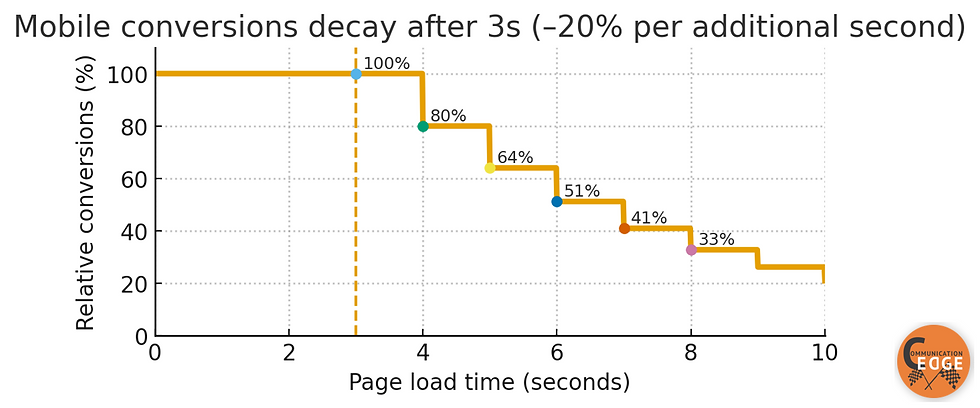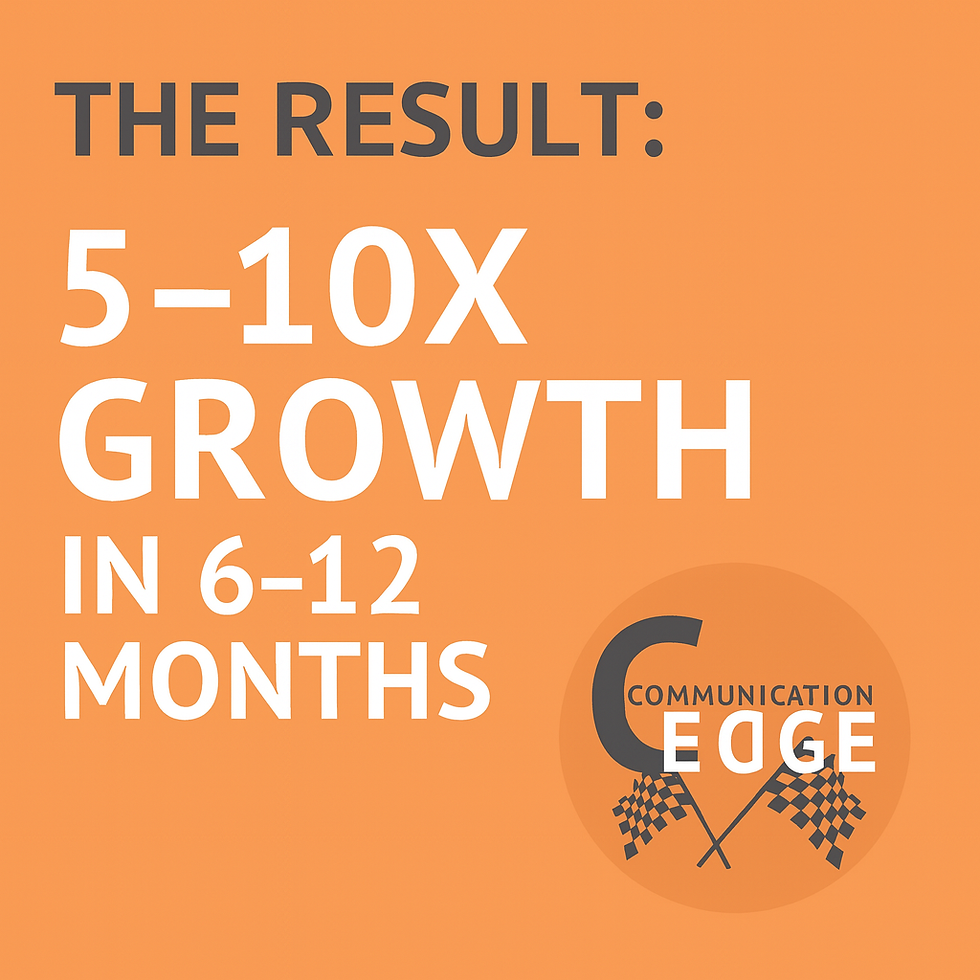Why Your Website Isn't Driving Growth? Get website traffic growth
- Simon Hunt
- Sep 3
- 5 min read
Updated: Oct 22
When Web Design Misses the Mark:
You hired an agency.You briefed them clearly.The site looks fantastic.
But six months later, the numbers tell a different story:
Google Lighthouse mobile performance scores: 39–62/100 (out of 100)
Website traffic: 100 visits/month vs competitors at 45,000/month
Keyword rankings: Mostly directional (“Who are you?”) or informational (“What do you do?”) — but nothing transactional or commercial (“How do you solve my problem?” or “Where do I buy?”)
The result? A pretty website that isn’t generating pipeline or revenue.
Here’s why this happens — and how to fix it.

1. Designed for Founders, Not for Users
Agencies often build sites around the preferences of one or two co-founders rather than the target audience’s intent.
Founders want it to look sleek and modern.
Agencies want to showcase their design flair.
Nobody owns user research, SEO strategy, or conversion pathways.
The site launches with visual polish but little commercial impact.
2. Mobile Performance = Ranking Power
With Lighthouse mobile performance scores between 39 and 62, Google sees your site as slow, clunky, and low quality on mobile — which is now the default device for 60–70% of users.
Below 50 = Poor UX → Lower rankings
50–89 = Needs improvement → Ranking potential limited
90+ = Competitive performance → Better visibility & conversion
If you want search traffic, site speed and technical SEO matter as much as the design itself.
Poor Google lighthouse scores ie 39-62 out of 100 hit you twice, here is how:
For every second over 3 seconds you lose 20% of your website visitors
So this sites home page loads in a speed index of 8.1 seconds
The site appears on a mobile device here's the impact summary:
4 seconds impact - only 80% of web visitors retained
5 seconds impact - only 60% """"""""""""""""""""""""""""
6 Seconds impact - only 40% """""""""""""""""""""""""""
7 Seconds impact - only 20% """""""""""""""""""""""""""
8 seconds impact - only 0 remain """""""""""""""""""""""""""""""'

Worse still Google penalises sites that perform poorly on mobile response speeds
Why?
Google wants high quality websites that deliver a good service to its customers
So failing to run technical audits, be aware of large images slowing sites down is like saying "I'm building a website and the objective is "not to rank in google and get traffic and if i do get traffic I don't want it to convert it to a lead.

3. Content That Doesn’t Match Search Intent
Ranking for directional keywords (“Company name”) or basic informational queries (“What is X?”) means you’re visible only to people already aware of you.
Your competitors ranking for:
Educational keywords (“How to solve problem X”) → capturing early-stage buyers
Commercial keywords (“Best solutions for Y”, “X vs Y comparison”) → catching high-intent prospects.
Transactional Keywords (Buy this)
That’s why they get 45,000 visits/month and you get 100.
Most Founders want a site that ranks, gets traffic and generates enquiries, however few know how to get there.

4. The Missing Marketing Engine
A website isn’t just a brochure. It’s the hub of a content + SEO + conversion system.
If you don’t:
Map buyer journeys - You can do this in 2 days, it requires a founder interview, chatGPT and some customer journey planning.
Publish educational & commercial/transactional content - this needs a calendar of activity publishing content where suspected customers learn. Usually off peers, linkedin groups, forums or Google search.
Build landing pages & lead magnets - Easy to do, measure and tweak.
Fix the technical performance of any problem pages or stages of the customer journey.
…then your site can’t generate pipeline, no matter how pretty it looks.

5. How to Fix It
Here’s the playbook:
a) Technical Audit & Performance Fixes
Use Google Lighthouse, SERanking, and Google Search Console
Compress images, enable caching, and fix code bloat
Target 90+ mobile scores for better SEO

b) Content Strategy by Search Intent
Informational: “What is…”, “How does…” for awareness stage
Educational: “How to fix…”, “Ways to improve…” to build trust
Commercial: “Best tools for…”, “X vs Y” for high-intent buyers
Transactional: "Buy xyz"

c) Conversion Pathways
Measure CTAs, lead forms, downloadable guides
Email nurturing & remarketing campaigns

d) Competitive Gap Analysis
Identify keywords competitors rank for that you don’t
Build topic clusters & cornerstone content around them

6. The Result
By fixing performance, expanding into educational & commercial keywords, and adding conversion-focused content, you can:
5–10X organic traffic in 6–12 months and get real website traffic growth
Cut reliance on paid ads
Generate qualified leads, not just page views

Conclusion: Stop Building Brochure Sites get website traffic growth
A website designed only for visual appeal — without SEO, speed, or buyer journey strategy — is like a shop with no road signs, slow service, and no salespeople.
Your competitors know this. That’s why they get 45,000 visits/month and you get 100.
FAQs on how to Build Website Traffic and Growth
What’s the most effective way to increase website traffic for SMEs?
Focus on a mix of SEO, targeted paid campaigns, and content built around buyer intent. Consistency and keyword-led optimisation deliver compounding growth over time.
How long does it take to see measurable website traffic growth?
Typically 3–6 months for steady organic results, depending on domain authority, content cadence, and optimisation. PPC can deliver immediate visibility while SEO builds momentum.
Which traffic sources deliver the highest ROI?
Organic search and email marketing often outperform paid channels in cost efficiency, while LinkedIn and PPC drive high-intent visitors when properly targeted and tracked.
Why is keyword research critical to traffic growth?Keyword research ensures content aligns with user intent and demand. It prevents wasted effort on terms that drive irrelevant clicks or poor-quality leads.
How does content quality impact website growth?
Google rewards expertise, depth, and engagement. Well-structured, data-backed articles reduce bounce rates and encourage backlinks — both essential for ranking and authority.
Can AI tools help accelerate traffic growth?
Yes. AI can speed up research, SEO optimisation, and content creation. However, human editing ensures accuracy, originality, and brand consistency.
What role does website speed and UX play in traffic retention?
Fast load times and intuitive design lower bounce rates and improve conversions. A Google Lighthouse score above 90 should be the baseline for performance.
How can analytics and tracking support sustainable traffic growth?
Using GA4, Search Console, and Looker Studio dashboards reveals which channels, pages, and keywords drive conversions, guiding continuous improvement.
What common mistakes prevent website traffic growth?
Publishing content without search intent alignment.
Ignoring technical SEO (sitemaps, meta data, page speed).
Failing to measure performance and ROI.
Not having a tool to analyse search word performance a content scores- SERanking.
How can SMEs turn website traffic into measurable business growth?
Link analytics to CRM data (e.g., HubSpot) to track how visitors convert into leads and revenue.





Comments